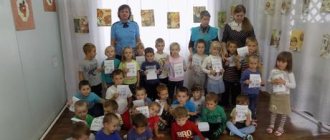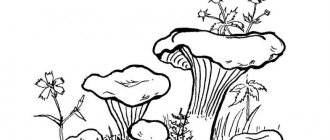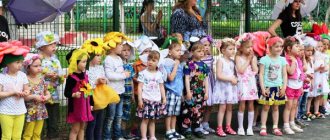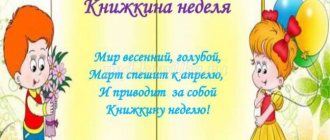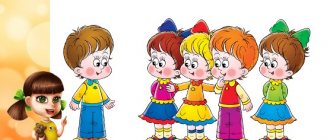Ecological week in kindergarten. Middle group
Project on the topic: “Environmental education of children of senior preschool age”
Ecological week “The Earth is our common home”
Goal: To consolidate and expand children’s knowledge about nature as an inexhaustible source of spiritual enrichment for people; awaken in children a keen interest and curiosity about the world around them; develop the child’s positive feelings towards nature. Objectives: — To form a system of basic environmental knowledge accessible to preschool children;
— Foster an emotionally positive, careful, caring attitude towards the natural world and the environment in general; — To develop skills in observing natural phenomena and objects. Monday
Excursion (walk) around the surroundings of the kindergarten.
Target:
Teach to notice changes occurring in nature, name the color of leaves, observe trees, understand what causes leaf fall, why insects have disappeared and birds fly away. Admire the beauty of autumn nature. Arouse interest in the world around you; to form a realistic idea of the nature around us; to develop skills in observing natural objects and phenomena. 1. Traveling around the world (looking at the globe; pay attention to the colors on the globe - water, land) 2. Making riddles about flora, fauna, insects. 3. Application on the theme: “Let’s decorate a scarf with a pattern of autumn leaves”
4. Examination of illustrations on the theme “Autumn in nature.” 5. . Game "Living - Nonliving." 6. Exercise “Color only the living.”
Tuesday
1. Recording bird observations in the observation calendar. Sorting material collected during walks. Making a herbarium. 2. Conversations in order to clarify ideas about the phenomena observed during walks. 3. Listening to “The Seasons” by P. I. Tchaikovsky and other music.
4. Reading and conversations after reading about the abilities of animals to adapt to their environment. 5. Making crafts from collected natural materials. Design from natural material on the theme: “Let’s put a butterfly on a flower”
6. Game “Review and Post.” Goal: To cultivate attention, patience, curiosity. 7. Printed board game “The sun is walking across the sky! Determine when this happens? 8. Conversation “This is not possible, but this is possible and necessary.” Discuss how to treat animals: sparrows, crows, cats, etc.
Wednesday
To consolidate children's knowledge about the phenomena of inanimate nature - water and its properties. Sun, air and water are our best friends. The arrival of “Aibolit” is a story about the healing powers of the sun and water (and the dangers). 1. Didactic game “Water is our helper” “Sorceress water” 2. Meeting of the “Why Chek” club. Topic: “Such different water” a) are all rains the same (spring, autumn, summer). b) are all clouds the same 4. Listening to the recording “The Sound of Rain” 5. Didactic game “What is the name of the chick?” 6. Ecological labor landing a) preparing a flower bed for the winter b) preparing seeds and leaves for the herbarium. 8. Solving riddles about the seasons. 9. Didactic game “Nest, hive, hole, or who lives where?”
Thursday
Poetry Day “Take care of the planet” 1. Exhibition of books about the planet. 2. Competition of readers about the animals of our forests (our forest zone (strip)) 3. Games “Guess the tree”, “Which tree is the leaf from? "(children make a “picture” from a set of small illustrations) 4. Reading Bianchi’s books: “Forest Houses” 5. . Memorizing poems about animals, plants, etc. 6. Improvisation of movements to the music of nature in an audio recording 7. Teacher's story about the behavior of birds and animals in the fall. 8. Didactic game - “What kind of wind?”
Friday
1. Entertainment for children on the topic: “Autumn walk” Purpose: To consolidate children’s knowledge about the seasons; autumn phenomena in nature. Expand knowledge about forest inhabitants in the autumn. Maintain interest in dance and music activities. 2. Competition of crafts made from natural materials for joint creativity between parents and children on the theme: “Look into the autumn forest” 3. Word game “Who has what fur coat?” 4. Work with parents: Final design of the exhibition on the theme: “Look into the autumn forest”
Walk-Monday
Cloud Observations.
Goals:
teach children to observe clouds, noting changes that occur; lead to the conclusion that cloudy weather is a characteristic sign of autumn.
Word game “Guess which tree the leaf comes from”
Didactic task:
determination of the distinctive features of leaves of maple, birch, rowan, etc.
Game action:
Find out and name the leaf corresponding to the tree.
Progress of the game
The teacher gives the children leaves of different shapes, and the children determine which tree they come from. — This leaf is from a birch tree, that’s why it’s called birch. — This leaf is from an oak tree, that’s why it’s called oak. - This leaf is from a rowan tree, that’s why it’s called rowan, etc.
Walk-Tuesday
Observing changes in nature: invite children to independently find signs of autumn in the surrounding nature.
Word game “Who has what fur coat?”
Didactic task:
Form coherent speech of a preschooler. Activate your vocabulary with words: fluffy, soft, smooth. Strengthen children's knowledge about animals.
Game action:
Guess the riddle about the animal proposed by the teacher and compose a descriptive story with the help of the teacher.
Progress of the game.
The teacher asks the children to guess a riddle about an animal. For example, What kind of forest animal is this? Stood up like a column under a pine tree. And stands among the grass - Are your ears bigger than your head? (Hare) After guessing the animal, the teacher encourages the children to remember and describe the appearance of the hare - What kind of fur coat does the bunny have? (white, fluffy, soft, etc.) - What kind of fur does the fox have? (red, soft, fluffy) - What kind of fur coat does the squirrel have? (soft, smooth)
Walk-Wednesday
Bird watching.
Target:
consolidate children's knowledge about birds - name, body parts, nutrition. Search and educational activity “Why do migratory birds leave us in the fall?” Goal: to help establish the dependence of the birds’ lifestyle on the lack of food during the cold season. Verbal exercise/game “Guess the riddle about the bird.”
Didactic task:
Exercise children in guessing riddles about birds. Fix the names of the birds: sparrow, tit, starling, crow.
Game action:
Listening and solving riddles. Finding the answer on cards with pictures of birds. (On a walk, you can do without cards; you can combine the game with a real bird and reward for the correct answer with pre-made birds using origami.)
Progress of the game.
The teacher asks the children riddles about birds. Little gray lump: Chik-chirk - he’s very cold! Sun, come out quickly! Who's waiting for warmth? (Sparrow) And in winter she can’t sit: She’s circling above my window, Asking for bread crumbs and wheat for breakfast... (Tit) The bird is chatty - no doubt, She’ll tell you news and secrets! Beautiful in appearance, white-sided Who? - Long-tailed... (magpie) - How can you call our guests in one word? Who is our guest? (Birds)
Walk – Thursday
Tree observations.
Target:
help children conclude that after the air temperature dropped below zero degrees (a noticeable cold snap), all the trees lost their leaves. Word game “Compare and tell how they differ?”
Didactic task:
To consolidate children's knowledge about the distinctive features of birds and animals.
Game rules:
Respond only when signaled by the teacher. Be able to listen to the opinions of your peers. Dialogue between the teacher and children using riddles about birds and animals, leading questions from the teacher to the children about the appearance and habits of animals and birds.
Progress of the game:
Using pictures of animals: fox, wolf, bear and hare. And birds: crow, sparrow, magpie. Children must find the differences and name them. (In older preschool age, the game is played in the fresh air, on a walk without pictures, the children act from memory and previous accumulated knowledge in the middle group) - How are birds and animals similar? (birds and animals have a body, eyes and a tail) - What do birds have that animals don’t? (birds have wings, but animals do not. Birds have a beak, and animals have a mouth. Birds have two legs, and animals have four. Birds have a body covered with wings, and animals have hair.
Walk – Friday
Wind observations.
Target:
To consolidate knowledge about the phenomena of inanimate nature. Determine the basic properties of wind. Bring children to the conclusion that wind is air movement that can have different strengths and directions. Word game “Which way is the wind blowing?”
Didactic task:
To consolidate children's knowledge about the phenomena of inanimate nature. Exercise in determining the basic properties of wind. Activate the speech of a preschooler. Develop observation and auditory attention.
Game action:
The teacher asks the children questions about what kind of wind is it today, what kind of wind can it be, what kind does it happen? Children use plumes or autumn leaves in their hands to determine the strength of the wind. (strong, gusty, cold, warm, autumn, etc.) Whoever answered the teacher’s question correctly, the first imitates the force of the wind.
Progress of the game.
The teacher invites the children to imagine a mental picture according to her words. — Clouds, rain, wind, tree branches sway, leaves turn yellow and fall to the ground, at what time of year does this happen (happens)? Children's answers: (in autumn). The teacher offers to sing a song of the autumn wind. - What wind? (strong, prickly, etc.) -But the wind began to subside. What wind is blowing now? (quiet) Note: The teacher can invite children to imagine a similar picture for another time of year, choosing words that highlight and define signs and natural phenomena of a particular time of year. (season) I bring to your attention a detailed description of the games that I used in the process of environmental education for children in the senior group throughout the entire project (one week) on environmental education. 1. Printed board game: “The sun is walking across the sky! Determine when this happens?
Didactic task:
To consolidate children's knowledge about the phenomena of inanimate nature: parts of the day.
Game rules:
Select colors according to the content of the text.
Game action:
Search for a card of a certain color based on the text content.
Didactic material:
colored cards. Model of a clock (a circle divided into four parts). Poetic texts about parts of the day.
Progress of the game.
As the teacher's story progresses, the children place the corresponding cards on the watch model. The sky suddenly turned pink, Quietly and timidly the Sun with a gentle ray What opened it like a key? (morning pink card) The sun shone brightly, the whole Earth was gilded. He shines and shines, doesn’t he tell us to be lazy? (day - yellow card) The sun has gone to bed, and as if He is covering the whole earth with a light blue blanket. Will the gnome read a fairy tale and quietly fall asleep? (evening-blue card) When did the Earth suddenly come together with the darkness, And in the sky did the moon come together with a star? Has the Dwarf been sleeping quietly for a long time? (at night - black card)
2. Didactic game with objects: “Water is our helper”
Didactic task:
To consolidate children's knowledge about the phenomena of inanimate nature - water and its properties.
Game rules:
Act only on a signal from the teacher. Select only those items that are necessary for the story and description. Maintain the order.
Game action:
Finding the right items.
Didactic material:
a basin with dirty laundry, soap and a toothbrush, a first aid kit with medicines; Pets; story card with a picture of a river, etc.
Progress of the game.
Children choose their favorite items on the table and give their explanations. — Residents of Flower City need water to wash their clothes. — Babies and toddlers need water to bathe and swim in the river. — Residents of the flower city need water to grow vegetables and fruits. — Doctor Pilyulkin needs water to make medicine and treat patients. — Cook Donut needs water to prepare lunches, breakfasts and dinners. — Shpuntik and Vintik need water to wash themselves after work. — All babies and toddlers need water to drink when it’s hot. Etc.
3. Game “Review and Post”
Didactic task:
To consolidate children's knowledge about the seasons and signs of autumn. Cultivate attention, curiosity, patience. Conduct basic comparative analysis, identify similarities and differences.
Game rules:
Act only on a signal from the teacher. Maintain the order.
Game action:
Children, at the teacher’s suggestion, lay out a color board on the “Seasons” clock. The main signs of autumn are laid out. Dialogue between teacher and children.
Didactic material:
“Seasons” clock, plot cards with signs of autumn according to the number of children.
Progress of the game
Children must identify and lay out on the table the main signs of autumn (another season). — What season should I set on our “Seasons” clock? (on the clock you need to set the hand to the season - autumn, the yellow part of the clock). -What time of year do I indicate to us the signs outside the window? (signs outside the window indicate to us that the time of year is autumn). -What signs of autumn did you put (address the girl or boy by name) on your table? (The sun in the sky has hidden behind a cloud, it is raining, there are puddles on the ground, a cold wind is blowing, the trees are without leaves, etc.)
4. Didactic game with objects “What is the name of the chick?”
Didactic task:
Exercise children in recognizing and naming birds: crow, sparrow, birdling, titmouse.
Game rules:
Children look at the figurine of a bird and its chick and answer the teacher’s question.
Didactic material:
figurines or pictures depicting birds and their chicks: baby crow; birdling starling; titmouse; little sparrow
Progress of the game:
The teacher shows a picture of a bird and its chick. The child must name the adult bird and its chick. - This is a sparrow, and the sparrow’s chick is a sparrow. Etc.
5. Didactic game “Nest, hive, hole, or who lives where?”
Note. Games can be played at any time of the day and used in various activities, at the discretion of the teacher. The rules of the games can also vary, which may depend on the creativity and resourcefulness of the teacher. The final stage of the environmental week was an event I developed - the “Autumn Quiz” entertainment. And also an exhibition-competition of crafts made from natural materials on the theme: “Look into the autumn forest.” Joint creativity of parents and children.
We recommend watching:
Abstract of educational activities on ecology in the senior group. Environmental education of children in kindergarten. Analytical report of a preschool educational institution on the organization of work. Section “Environmental education” Environmental project in kindergarten
Similar articles:
Scenario for an environmental event in kindergarten
Summary of educational activities for the development of environmental concepts in children of the senior group
Abstract of GCD on ecology in the preparatory school group
Ecology in music
Lesson summary on the topic “The Red Book” in the preparatory group
Long-term plan for environmental education in the middle group
Long-term plan for environmental education in the middle group
SEPTEMBER
"Flowers on the site in autumn"
To consolidate children's knowledge about autumn garden flowers: differences in appearance, stages of seed ripening. Clarify children's ideas about gardening in the fall. Activate children's vocabulary with words meaning the names of garden flowers.
Making riddles, Purpose: To teach children to distinguish fruits and vegetables by touch, to name and group them, observation.
Parent meeting: topic “What is ecology.”
“What autumn gave us”
Strengthen children's knowledge about vegetables and fruits. Clarify children's knowledge about caring for vegetables. Cultivate hard work. Activate children's vocabulary with words denoting vegetables and labor actions.
Reading poems “Hello, autumn!” E. Blaginina, observation, conversation “What grows in the garden?”, D/I “Vegetables and fruits”.
Exhibition “Gifts of Nature” - vegetables and fruits grown by parents.
"Autumn in white mists"
Clarify children's knowledge about such a natural phenomenon as fog. Develop cognitive activity. Activate children's vocabulary: fog, damp, damp, thick cover.
Conversation “What is this fog?”, reading poetry, environmental fairy tales, asking riddles, observation.
Consultation for parents “Environmental education in the family”
“Now a birch tree, now a mountain ash”
Continue to familiarize children with the characteristic features of trees and seasonal changes. Cultivate a love for nature.
Reading poems: “Birch Tree”, “Rowan Tree”, game “Describe the Tree”, asking riddles, observation
Creation of the “White Birch” application - joint work of parents and children
OCTOBER
"Good, good sun"
Clarify children's knowledge about the sun in autumn. To develop the ability to determine the weather by signs. Activate children's vocabulary: water, heat, light, earth
Reading poetry: “Four treasures...” M. Makhaneva. Observation, “Palm” experience,
Reading environmental literature to children, looking at illustrations.
"Tell Piggy about houseplants"
Clarify children’s ideas about plants in the group and the living conditions necessary for them. Introduce new plants. Teach to recognize and name parts of a plant (root, stem, leaf, flower). Cultivate interest in research activities. Encourage the desire to care for plants, treat them with love and tenderness.
Articulation gymnastics, Game “Find the plant”, physical education, did-kaya, etc. “What plant did Piggy hide behind?”, summary
Seminar-workshop for parents “In the kingdom of medicinal plants”
"Autumn Tree"
To develop children’s ability to observe natural phenomena, analyze and draw conclusions about certain relationships and patterns.
Unconventional drawing technique: blotography - experimentation
Exhibition “Wonderful Pictures from Dried Blades of Grass.” Teamwork of children and parents
"Pets"
To form in children generalized ideas about domestic animals: how to care for them, what benefits they bring, what conditions are needed for life.
Conversation, use of a bad word, finger game “Clouds”, game “Remember and name”
Consultation “Pets in a child’s life.”
“How many rains have I known”
Develop children's ability to observe seasonal phenomena and their changes. To develop the ability to identify the characteristic signs of autumn and summer rain. Activate children's vocabulary: drizzling, cold, etc.
Communicative dance game “Waltz of Friends”. Singing “Cloud”, “Drip, drip...” music. I. “Sunny bunnies and clouds” finger and. "Clouds"
Consultation “Save water.”
NOVEMBER
"Sparrow"
Introduce children to wintering birds: sparrows. (Check with the children how changes in nature affected the sparrow’s life). Develop an interest in bird watching. Activate children's vocabulary: wintering, migratory.
Outdoor game “Who lives in the house?” Natural signs. Finger massage "Rooks". Bird calls
Speech game “Who is this?”
(abstract)
"Birdhouse" Making feeders.
“Titmouse holiday - November 12”
To form in children a desire to treat living nature kindly. Learn to organize your own feeding of birds regularly.
Conversation “Guess which bird”, observation, use of literary words, sub. game "Fox and Birds".
Consultation “On the benefits of environmental fairy tales”
"Wild Animals in Winter"
Continue to develop knowledge about forest inhabitants. To develop in children ideas about the sequence of events in the life of forest animals.
Reading poems, creative tasks, sub. game "Hares and the Wolf", conversation.
Ecological excursion to the zoo
"Snowflake"
Develop the ability to observe seasonal phenomena and their changes, attention and memory, and see the beauty of nature. Activate children's vocabulary: first snow.
Observation, conversation, reading educational stories, problem situation.
DECEMBER
"Protect spruce and pine"
Introduce children to the concept that cones contain the seeds of coniferous trees. To develop children’s ability to distinguish between a spruce and a pine cone. Activate children's vocabulary: spruce, pine.
Observation, conversation, game “Find by description
Competition of children's works made from natural and waste materials (cones, twigs, leaves, etc.)
"Clouds floated across the sky"
Expand children's understanding of inanimate natural phenomena:
tell the children what types of clouds there are. Development of observation skills. Activate children's vocabulary: cirrus, stratum, cumulus.
Conversation “What types of clouds are there”, observation, use of literary words.
Children's drawing competition “A cloud walked across the sky”
"Snow Round Dance"
Continue to teach children to observe natural phenomena: snowfall and see the beauty of the world around them. Activate children's vocabulary: cold, white, sparkling, fabulous, etc.
Observation, examination of the painting “Winter”, productive, experimental (snowball) activity.
Consultation “How to properly prepare tea”, “the benefits of lemon”.
"Winter beauty - spruce"
Introduce the desire to enjoy the smell of pine wood. promote the development of the ability to name the characteristic features of the structure of a spruce, the signs that distinguish it from other trees, the formation of the ability to see the difference between a toy spruce and a real one; cultivate a caring and caring attitude towards living nature.
A surprise game moment, compiling a descriptive story about a spruce based on a plan, an imitation game “Collect cones,” a conversation “Should a person protect the beauty of nature?” Creative work, summary
Consultation “Treasures of the Forest” (The role of the forest in human life; what a person gets from the forest, how to behave in the forest; human help to the forest.)
JANUARY
"Observation of Snow and Ice"
Develop a realistic understanding of inanimate nature;
consolidate knowledge that water can be in a solid state (snow, ice).
Conducting experiments, outdoor games
“Entertainers”, “Firemen in training”, use of artistic words.
Reading environmental literature to children, looking at illustrations.
"Bird Life in Winter"
Teach children to look at birds, distinguish them by size, plumage color, and sounds made. Introduce them to their names.
Conversation, game “Feed the bird”, did. And. “They fly away - they don’t fly away.”
Creation of a stand “Winged Doctors” (Introduce birds that you can follow
Observe)
“Moroz is an amazing artist”
Arouse children's interest in winter natural phenomena. Develop visual observation, the ability to notice unusual things in the world around you and the desire to reflect what you see in your work. Develop imagination and creativity.
Asking riddles, observing while walking, using bad words,
practical work
(abstract)
Creation of an environmental newspaper on the topic: “Interesting things are nearby”
FEBRUARY
“Growing onions in the window”
Arouse interest in growing a vegetable garden in a window, a desire to observe changes in the bulbs. Learn to create an experience situation
Conversation with elements of labor.
Consultation at the stand in the parent corner “Onion Treatment”
"Wild animals in the forest in winter"
To contribute to: enriching and deepening children’s knowledge about wild animals in winter, developing the ability to establish connections between winter conditions and the behavioral characteristics of animals.
Conversation about squirrel, hedgehog, hare, fox, bear. Completing a creative task. game “We are little bunnies”, game “Finish the sentences”.
Making the album “Domestic and Wild Animals”.
"Laboratory of Good Deeds"
To form the concept of kindness, the habit of doing good deeds; cultivate interest in experimental activities; learn to put forward hypotheses and assumptions; analyze phenomena, draw conclusions; develop cognitive interest, logical thinking, and speech of children; bring a feeling of joy to children
Conversations about natural phenomena, disasters (earthquakes, volcanoes, tornadoes, hurricanes, floods), experiments with water and air; reading educational literature; conversations about good and evil.
Ecological conversation in
"Towards nature with kindness"
"Observing Seasonal Changes"
form ideas about changes in nature;
— learn to distinguish the characteristic signs of the end of winter (the first drops); - consolidate the ability to perceive a poetic description of winter.
Using a bad word, Outdoor games: “Sly Fox”, “Who will make the least jumps?”
Buy an album for children with a recording of P. I. Tchaikovsky’s music “The Seasons”
MARCH
“Spring is coming to us with quick steps”
Continue learning to remember the names of the spring months; give an idea of the changes that occur in nature in early spring. Develop basic research skills and logical thinking.
Reading the poem “March”, “Spring is Coming”, d.i. “Find the mood. Show your mood”, observation.
Consultation at the stand in the parent corner “How to dress a child in spring?”
“Our four-legged friends – the dog”
To form in children the idea that a dog is an intelligent pet, devoted to a person, it can be trained and used in various useful services.
Observation, Outdoor games
"Friendly couples", "Separate - don't fall."
Photo exhibition
"My favorite pet"
"Health care"
To promote in children a caring attitude towards their health; to form the idea that in spring, vitamin foods (green onions, etc.) and the sun are especially useful; develop in children the ability to take care of their health; cultivate feelings of care for a sick comrade.
The game “Rejoice in the Sun”, “What is good for health, what is harmful”, a conversation about vitamin food.
Creating a folder-piggy bank “Grandma’s advice.”
"The first flowers in nature"
Encourage children to enjoy the first spring flowers, continue to familiarize them with the names and structural features.
Comparative story about coltsfoot and dandelion, riddles, poetry reading.
Consultation “Don’t destroy the primrose.”
APRIL
"Ladybug"
Teach children to be attentive to the world around them. Cultivate interest in natural phenomena, clarify ideas about the external features of the bug.
Watching a ladybug. Learning nursery rhymes, productive activities, finger gymnastics “Ladybugs”.
Collecting the collection “Insects and their friends”
"Feathered Guests"
To help generalize ideas about birds in the spring: changes in their behavior - basking in the sun, in trees, chirping, nesting, hatching chicks, etc.; cultivate curiosity and a desire to care for birds.
Conversation, making birdhouses, watching birds in the kindergarten area, looking at illustrations (different types of nests, appearance of chicks, etc.).
Operation Gift to the Birds. Making birdhouses and feeders with the help of parents and hanging them on the territory of the kindergarten.
"Spring Landscape"
To consolidate children’s ideas about spring and the characteristic features of this time of year. Draw children's attention to the first signs of spring. To instill in children a love for their native land. To develop children's interest in living nature and emotional responsiveness.
Conversation, literary expression, examination and comparison of paintings on the theme “Spring”, riddle, turning children into artists, listening to the melodies “Seasons”.
Exhibition of children's drawings "Spring Bouquet"
"Sun on the grass"
To clarify children’s knowledge of a flower, the ability to find it by leaves, the shape of the inflorescence, to develop children’s interest in working with paint. Continue to arouse children's interest in fresh flowers.
Reading poetry, finger gymnastics, productive activities (notes)
Reading environmental literature to children, looking at illustrations.
MAY
"Who lives in the pond?"
Introduce children to a pond - a natural body of water, its inhabitants, plants, to develop knowledge that the pond should not be littered; generalize ideas about the main factors of the aquatic environment: natural soil layer, water, stones, plants that have adapted to live in water.
Examination of the painting “Pond”, game “Create your own pond”. conversation, game “Imitation”, competition “Who is ready to save the reservoir?”..
Consultation “Save water.”
"Blooming trees"
To help familiarize children with the peculiarities of the spring state of fruit trees, to develop the ability to establish the simplest connections: changing conditions in the environment, to cultivate interest in plants, respect and care.
Conversation about apple trees, cherries, lilacs.
Game “Which tree is the flower from, Game - imitation “Collect nectar”
Collect broken tree branches with the children and place them in the water for observation.
“What are clouds, rain, thunderstorm?”
Give the concept of water evaporation, cloud formation, and electrical discharges in an accessible form. Introduce children to the rules of behavior during a thunderstorm.
Observation,
looking at illustrations,
reading, notes.
Workshop “Game Ecology”
"Sand Fantasies"
Expand children's horizons: introduce them to modern trends in fine art. To consolidate knowledge about the properties of sand. Develop imaginative and logical thinking. Develop tactile sensitivity and fine motor skills of the hands. Enrich the emotional sphere of children
Reading riddles, the game “Sand Telegraph”, music and rhythm exercise “Wave”, finger gymnastics “I am sitting on the sea sand”, independent activities of children
Conversation about environmental education of children. Final questionnaire for parents
7
